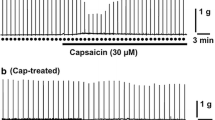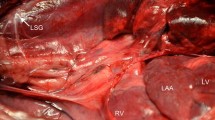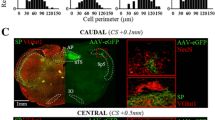Abstract
In chloralose-urethane anesthetized rats, compound spike potentials provoked in the cervical vagus nerve with electrical stimulation of the central cut end were found to consist of three major groups, A, delta-B and C. A remarkable cardioinhibition was observed on repetitive stimulation of the vagus nerve with an intensity which gave rise to the delta-B spike potential group. However, when the stimulus intensity was increased further beyond the level where the delta-B potential group had reached the maximum, the potency of cardioinhibition continued to be reinforced with the development of the C potential group. Selective activation of C fibers by anodal block of conductions along A and delta-B fibers was still associated with a considerable degree of cardioinhibition. These findings indicate that activities of both C fibers and delta-B fibers contribute to vagal cardioinhibition in rats and the view that the vagal cardioinhibition is mediated by B fibers, although valid in cats, can not be held applicable to all species of mammalians.
Similar content being viewed by others
References
Accornerro, N., Bini, G., Lenzi, G. L., Manfredi, M.: Selective activation of peripheral nerve fibre groups of different diameter by triangular shaped stimulus pulses. J. Physiol. (Lond.)273, 539–560 (1977)
Árahám, A.: Die Nervenversorgung der Kranzgefäße des Herzens. Arch. Int. Pharmacodyn.139, 17–27 (1962)
Agostoni, E., Chinnock, J. E., Daly, M. de B., Murray, J. G.: Functional and histological studies on the vagus nerve and its branches to the heart, lungs and abdominal viscera in the cat. J. Physiol. (Lond.)135, 182–205 (1957)
Chase, M. R., Ranson, S. W.: The structure of the roots, trunk and branches of the vagus nerve. J. Comp. Neurol.24, 31–60 (1914)
Daly, M. de B., Evans, D. H. L.: Functional and histological changes of the vagus nerve of the cat after degenerative section at various levels. J. Physiol. (Lond.)120, 579–595 (1953)
Duclaux, R., Mei, N., Ranieri, F.: Conduction velocity along the afferent vagal dendrites: A new type of fibre. J. Physiol. (Lond.)260, 487–495 (1976)
Evans, D. H. L., Murray, J. G.: Histological and functional studies on the fibre composition of the vagus nerve of the rabbit. J. Anat. (Lond.)88, 320–337 (1954).
Heinbecker, P.: The potential analysis of the turtle and cat sympathetic and vagus nerve trunk. Am. J. Physiol.93, 284–306 (1930)
Heinbecker, P.: The effects of fibers of special types in the vagus and sympathetic nerves on the sinus and atrium of the turtle and frog heart. Am. J. Physiol.98, 220–229 (1931)
Heinbecker, P., Bishop, G.: Studies on the extrinsic and intrinsic nerve mechanisms of the heart. Am. J. Physiol.114, 212–223 (1935)
Iriuchijima, J., Kumada, M.: Activity of single vagal fibers efferent to the heart. Jpn. J. Physiol.14, 479–487 (1964)
Jewett, D. L.: Activity of single efferent fibres in the cervical vagus nerve of the dog, with special reference to possible cardio-inhibitory fibres. J. Physiol. (Lond.)175, 321–357 (1964)
Kabat, H.: The cardio-accelerator fibers in the vagus nerve of the dog. Am. J. Physiol.128, 246–257 (1940)
Kunze, D. L.: Reflex discharge patterns of cardiac vagal efferent fibres. J. Physiol. (Lond.)222, 1–15 (1972)
Li, C.-L., Mathews, G., Bak, A. F.: Action potential of somatic and autonomic nerves. Exp. Neurol.56, 527–537 (1977)
Mei, N.: Disposition anatomiques et propriétés électrophysiologiques des neurones sensitifs vagaux chez le Chat. Exp. Brain Res.11, 465–479 (1970)
Middleton, S., Middleton, H. H., Grundfest, H.: Spike potentials and cardiac effects of mammalian vagus nerve. Am. J. Physiol.162, 545–552 (1950)
Mizeres, H. J.: Isolation of the cardio-inhibitory branches of the right vagus nerve in the dog. Anat. Rec.123, 437–445 (1955)
Murray, J. G.: Innervation of the intrinsic muscle of the cat's larynx by the recurrent laryngeal nerve: A unimodal nerve. J. Physiol. (Lond.)135, 206–212 (1957)
Paintal, S.: The conduction velocities of respiratory and cardiovascular afferent fibres in the vagus nerve. J. Physiol. (Lond.)121, 341–359 (1953)
Smith, D. C.: Synaptic sites in sympathetic and vagal cardioaccelerator nerves in the dog. Am. J. Physiol.218, 1618–1623 (1970)
Thorén, P., Shepherd, J. T., Donald, D. E.: Anodal block of medullated cardiopulmonary vagal afferents in cats. J. Appl. Physiol.42, 461–465 (1977)
Author information
Authors and Affiliations
Rights and permissions
About this article
Cite this article
Nosaka, S., Yasunaga, K. & Kawano, M. Vagus cardioinhibitory fibers in rats. Pflugers Arch. 379, 281–285 (1979). https://doi.org/10.1007/BF00581432
Received:
Issue Date:
DOI: https://doi.org/10.1007/BF00581432




